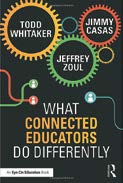Sections / Articles
What Connected Educators Do Differently
 Todd Whitaker, Jeffery Zoul, and Jimmy Casas.
Todd Whitaker, Jeffery Zoul, and Jimmy Casas.
Routledge, 2015 172 pp.
Principal, November/December 2015
Whether it is creating engaging classroom lessons, developing dynamic schoolwide programs, or taking control of their own professional development, collaboration is a critical practice for educators. Todd Whitaker, Jimmy Casas, and Jeffrey Zoul model this in their latest collaboration, What Connected Educators Do Differently. The trio provide expert advice on how to overcome the two biggest challenges to collaboration: time and people. By harnessing the power of technology and social media, the “connected educator” can collaborate anytime and with anyone, anywhere.
The authors begin by stressing the importance of investing in a P2LN— professional and personal learning network— which is the 21st century version of the professional learning community, but without the typical constraints. In the P2LN, connected educators connect with who they want, when they want. Educators need to, “stop pretending it is a notebook-paper and three-ring binder world out there … if we want to prepare our students for the rest of this century and beyond, then we must quit living in the last half century and recognize the value of becoming a connected educator,” the authors advise.
This book is an easy, yet powerful read for educators at any level. For those newly connected, or looking to connect for the first time, Whitaker, Casas, and Zoul explain how to harness the power of social media to improve schools. They review popular tools such as Twitter, Facebook, Instagram, blogs, and podcasts as learning tools. The “Follow 5, Find 5, and Take 5” section at the end of each chapter provides readers with five professionals to add to their P2LN, five resources for their professional growth, and five inspirational action steps moving forward.
For those who believe that nothing takes the place of face-to-face collaboration, the authors agree. They discuss several instances where their online relationships led to face-to-face connections, such as the development of the growing Ed Camp movement. Despite the title, the overarching theme in this book is not technology— it is the importance of relationships. Becoming a connected educator allows for new relationships to form and flourish, thus contributing to both personal and professional growth.
Reviewed by Robert Shappell, principal of Wilbur Watts Intermediate School in Burlington City, New Jersey.
Copyright © National Association of Elementary School Principals. No part of the articles in NAESP magazines, newsletters, or website may be reproduced in any medium without the permission of the National Association of Elementary School Principals. For more information, view NAESP's reprint policy.
| Attachment | Size |
|---|---|
| PrincipalsBookshelf_ND15.pdf | 70.16 KB |